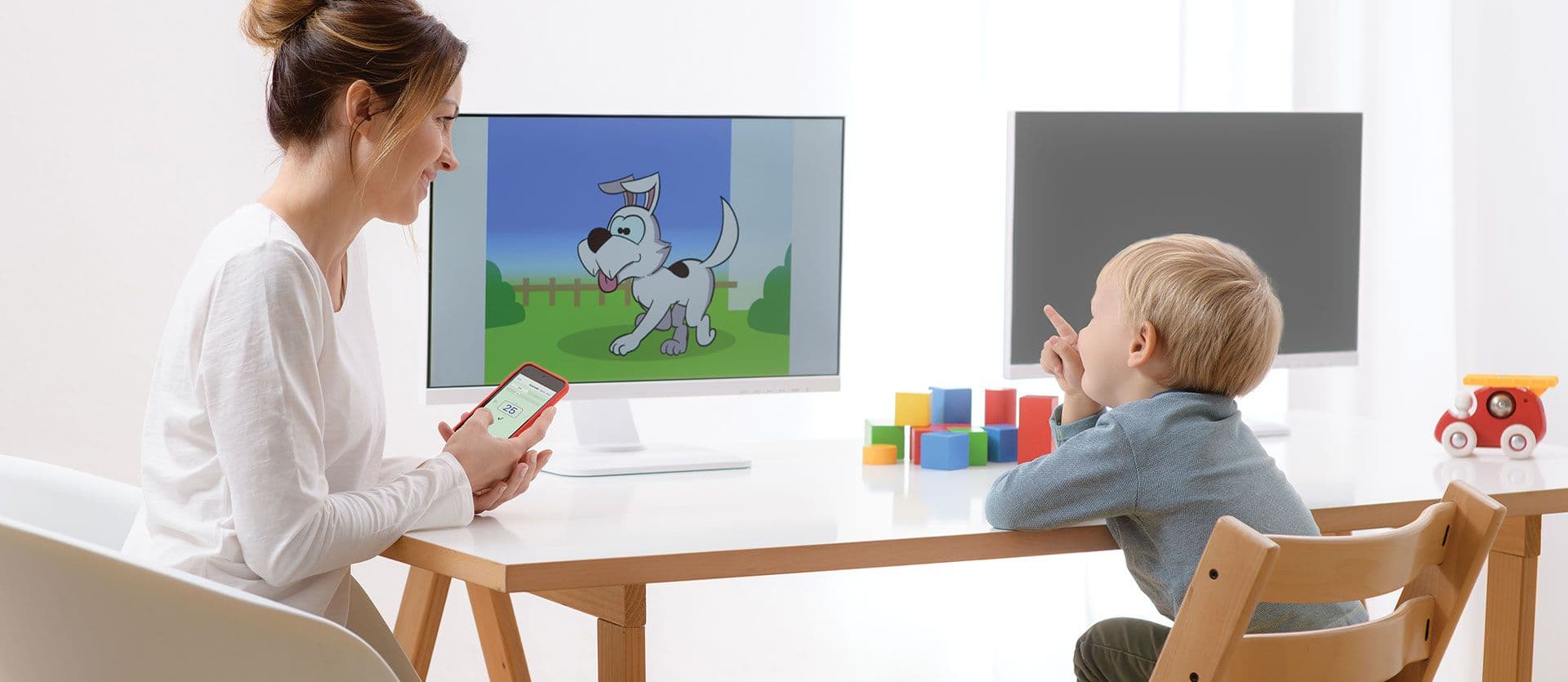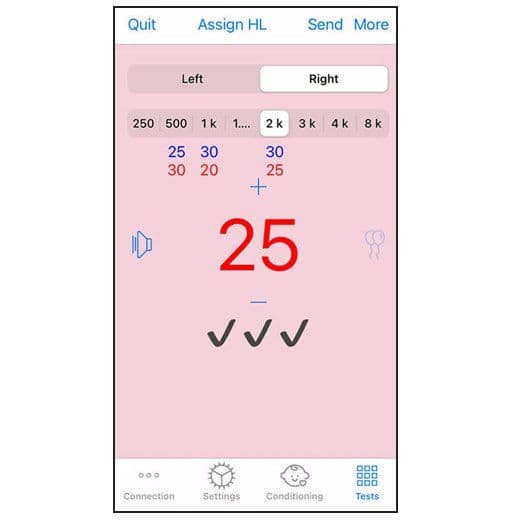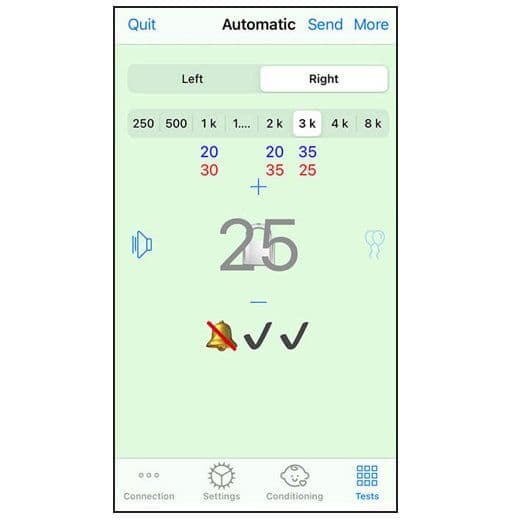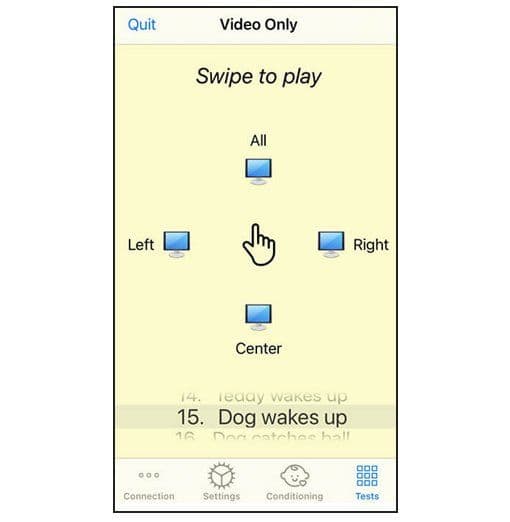
Change The Way You VRA - ONE DEVICE – ONE CLINICIAN
VRA Features
- iPad Audiometer Control
- iPad Video Reward Control
- Testing with One Clinician
- 52 Animated Videos (Default) can add custom videos too
- Any Size Monitor
- Wireless Monitor Communication (Optional)
- 4 Modes: Automatic Test, Manual Test, Conditioning or Video Only
- A2D+ Audiometer, ARC and AWRC Compatible
1:12 – Visual Reinforcement Audiometry with MedRx iVRA
VRA Reimagined. A New Form Of Visual Reinforcement Audiometry
Test – Store – Reward – Review – Interact. MedRx has integrated National Acoustic Laboratories technology and is now offering Visual Reinforcement Audiometry as an add-on to the new MedRx Studio Software. The VRA system takes a new approach to VRA testing. This system uses an iOS device to act as an audiometer controller and VRA controller. A clinician is able to adjust level, frequency, presentation ear, presentation and visual rewarding from the MedRx iVRA iOS app. Take advantage of four modes: conditioning, manual test, automatic test and video only. Change the way you VRA with the all new MedRx iVRA. A2D+ Audiometer, AVANT ARC and MedRx AWRC compatible.
Contact Us For More Information
Get a Quote
Visual Reinforcement Audiometry with MedRx iVRA
The MedRx iVRA is designed to allow clinicians to perform traditional VRA* and a new innovative form of VRA
MedRx has exclusively partnered with National Acoustic Laboratories (NAL) to revolutionize how clinicians can perform visual reinforcement audiometry tests. The MedRx iVRA allows clinicians to step beyond the traditional limitations of visual reinforcement audiometry (VRA) procedures by moving from a two person task into clinician only task, thus eliminating the need for an assistant during testing. Our system can do this with the use of an iOS device that acts as an audiometer and VRA controller. A clinician is able to adjust level, frequency, presentation ear, presentation and visual rewarding from the MedRx iVRA iOS app. The iVRA app allows clinicians to take advantage of four modes: conditioning, manual test, automatic test and video only.
The MedRx iVRA is a combination of the MedRx Studio Software and the MedRx iVRA iOS application. The combination of MedRx software and iOS device allows for new and innovative VRA strategies during testing. MedRx Studio Software allows a clinic to host up to three VRA monitors (left, right and center) to present visual rewards to the child. When paired with the MedRx Audiometer, MedRx iVRA iOS application will function as both the audiometer controller and reward presentation remote, while without the audiometer, it functions as just the reward presentation remote.
MedRx iVRA paired with a MedRx audiometer helps clinicians perform VRA tests with ease. With the MedRx iVRA setup, the MedRx iVRA iOS app connects with the MedRx Studio software, reward screens and the audiometer. The MedRx iVRA iOS app can then control our audiometer by presenting tones, adjusting presentation frequency, changing presentation ears, choosing videos, presenting visual rewards and saving results. With a simple user interface that can be controlled discretely without the need to look at the application, the connection between the MedRx iVRA app and audiometer allows the clinician to then walk away from the audiometer and perform both assistant and clinician functions in the booth with the child. No more coordinating schedules and limited slots. A clinician now has the flexibility to perform visual reinforcement audiometry at any time their schedule permits.
MedRx iVRA when paired with MedRx audiometers have the ability to perform two types of testing. The iOS App has manual and automatic testing functions.The two types of testing have their own benefits and help the clinician during visual reinforcement audiometry which can be a dynamic test. In general, the manual testing allows full control for the clinician while the automatic lowers bias and allows the clinician to focus on the child. We have built in catch trials and masking for the clinician to help prevent any bias during testing. MedRx iVRA app will also record everything that occurred during testing. This includes all presentation levels, correct responses and false positives to allow clinicians to view the test afterwards in Studio software to determine accuracy.
Automatic Test Mode – Allows the clinician to focus on the child they are testing. The automatic function allows the clinician to start the testing at any desired frequency and level. Once the testing begins, the stimulus will adjust levels automatically until threshold is determined. The clinician simply needs to signal when the child is ready to receive the stimulus and whether there is a response. NAL has developed automatic protocols which will adapt the presentation level of the stimulus and allow the clinician to focus on the child they are testing. The clinician then chooses the next frequency to test and continues until complete.

Manual Test Mode – Provides the clinician with full control. The manual function provides the clinician with full control of the stimulus presented to the child. Quickly and easily change ears, frequency and level all from the app to keep the child’s interest during testing. The clinician will have to determine the threshold and set it for the frequency. Once the test has been completed they can send all the results to Studio software.
The initial association of the stimulus and visual reward is called Conditioning. The In the Conditioning mode, the visual reward is associated when the stimulus is played to encourage responses. Conditioning is required for most children prior to the test start. The child is presented tones at a comfortable volume and the stimulus is paired with the visual reward. The clinician is free to present tones and video at any point, with any frequency and stimulus level to condition the child. After several presentations the child will begin to look for the visual reward when the stimulus is presented, and the clinician is now ready for testing.
The MedRx iVRA system will allow for traditional VRA through the use of our video only mode. In this video only mode, you can pair our VRA system with any audiometer no matter the brand or age. Simply connect the presentation screens to a PC with the MedRx iVRA system. With the Studio VRA software and MedRx iVRA iOS app you can present video rewards onto the screens rewards. The iOS app is our video activation remote allowing the clinician to present rewards on up to three screens individually or simultaneously. Our software has incredible flexibility which will allow you to randomize videos, upload custom videos or order the videos so the clinician can select specific videos.
Awards and Recognition
The MedRx iVRA product was entered into the 2020 Hearing Health Innovator awards under the Equipment category. Clinicians voted for and determined that the MedRx iVRA was an innovative solution and awarded it the Bronze award. We are very proud of the changes that this product will provide in the industry. This great innovation will allow individual clinicians to broaden the services provided to customers by allowing them to perform full VRA testing without extra help from an assistant.
*Traditional Visual Reinforcement Audiometry
Visual Reinforcement Audiometry, also known as VRA, is audiometric testing designed for pediatric patients between the ages of 6 months and 2-3 years. The testing may also be called visual reinforced orientation audiometry (VROA) in certain countries. Visual reinforced audiometry is an ideal test for children unable to provide verbal or push-button responses. Instead, VRA uses a head turn response that is a natural reaction to sound presented from the side. This is paired with a visual reward when the stimulus is being played to encourage responses. The initial association of the stimulus and visual reward is called Conditioning. Conditioning is required for most children prior to the test start. The child is presented tones at a comfortable volume and the stimulus is paired with the visual reward. After several presentations the child will begin to look for the visual reward and the clinician is now ready for testing.
There are two types of visual rewards in VRA testing: animated puppet and animated video clips. The visual rewards need to capture the child’s attention so that they are encouraged to look in the direction of the stimulus.
The visual reward and the speaker need to be next to each other in order for the child to associate the sound with the visual reward. The ideal system will provide a base set of videos and the ability to upload new videos that are relevant to children as time passes.
Traditional visual reinforcement audiometry is performed with a clinician and an assistant. The clinician will present the stimulus and monitor the child for response. The child is monitored during testing through a window or camera for head movements indicating a response. An assistant will be in the room with the child teaching the task, cueing rewards and helping to bring the child back to center using various distractors. Many times, the assistant is under masking noise to prevent any bias. The process requires both the clinician and assistant to understand the task at hand and have open time in their schedule for the visual reinforcement audiometry appointment.







